Jan 20, 2025
•
Onton Team
Discover the essence of minimalist interior design, where simplicity meets functionality. Create serene, clutter-free spaces that enhance your modern living experience.
Minimalist interior design embodies the principle of "less is more." It focuses on creating spaces that are simple, uncluttered, and functional. This approach emphasizes clean lines, neutral colors, and carefully selected pieces that serve a purpose.
Minimalist design strips away excess to reveal the essential beauty of a space. By removing unnecessary elements, it allows key features like architectural details or natural light to shine. You'll find that minimalist interiors often feature open layouts, natural materials, and a restrained color palette.
Adopting minimalist design principles can transform your living spaces. It encourages you to let go of clutter and focus on what truly matters. The result is a calm, organized environment that promotes clarity and peace of mind. Whether you're redesigning your entire home or just looking to refresh a single room, minimalist concepts can help you create a more serene and intentional living space.
Key Takeaways
Minimalist design focuses on simplicity, functionality, and essential elements
Open spaces, neutral colors, and natural materials are key components
This approach can create calm, clutter-free environments that enhance well-being
What Is Minimalist Interior Design?
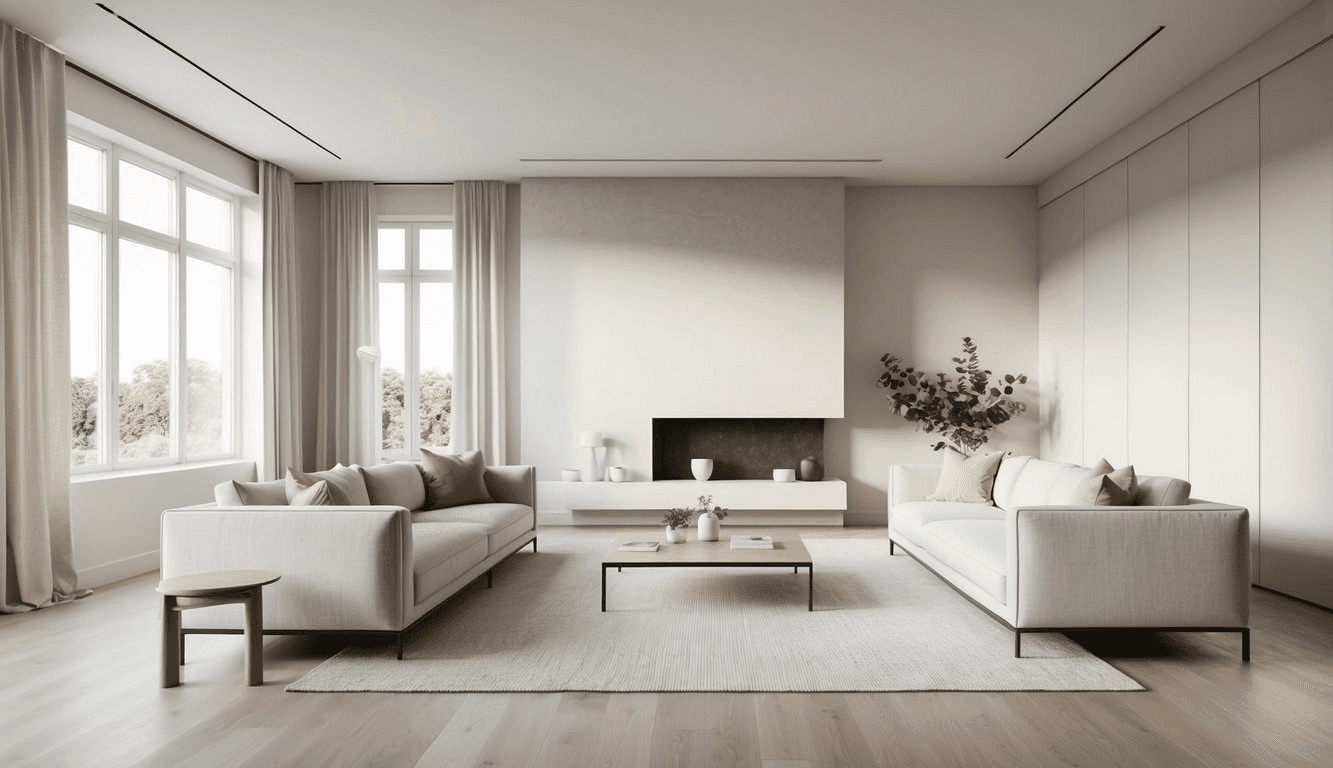
Minimalist interior design embraces simplicity and functionality. You'll find it characterized by clean lines, uncluttered spaces, and a focus on essential elements. This approach aims to create serene environments free from excess.
In minimalist spaces, you'll notice a limited color palette. Neutral tones often dominate, with occasional pops of color used sparingly. Furniture and decor are chosen with intentionality, favoring quality over quantity.
Key elements of minimalist design include:
Open floor plans
Ample natural light
Hidden storage solutions
Multifunctional furniture
Minimalist style emphasizes the "less is more" philosophy. You'll see carefully curated spaces where each item serves a purpose. Unnecessary decorations are eliminated, allowing the essential pieces to shine.
Textures play an important role in adding depth to minimalist interiors. You might encounter smooth surfaces contrasted with natural materials like wood or stone. These elements bring warmth and interest without cluttering the space.
Remember, minimalism isn't about living with nothing. It's about surrounding yourself with items that truly matter to you. This intentional approach creates calm, focused environments that can reduce stress and improve well-being.
History And Origins Of Minimalist Design
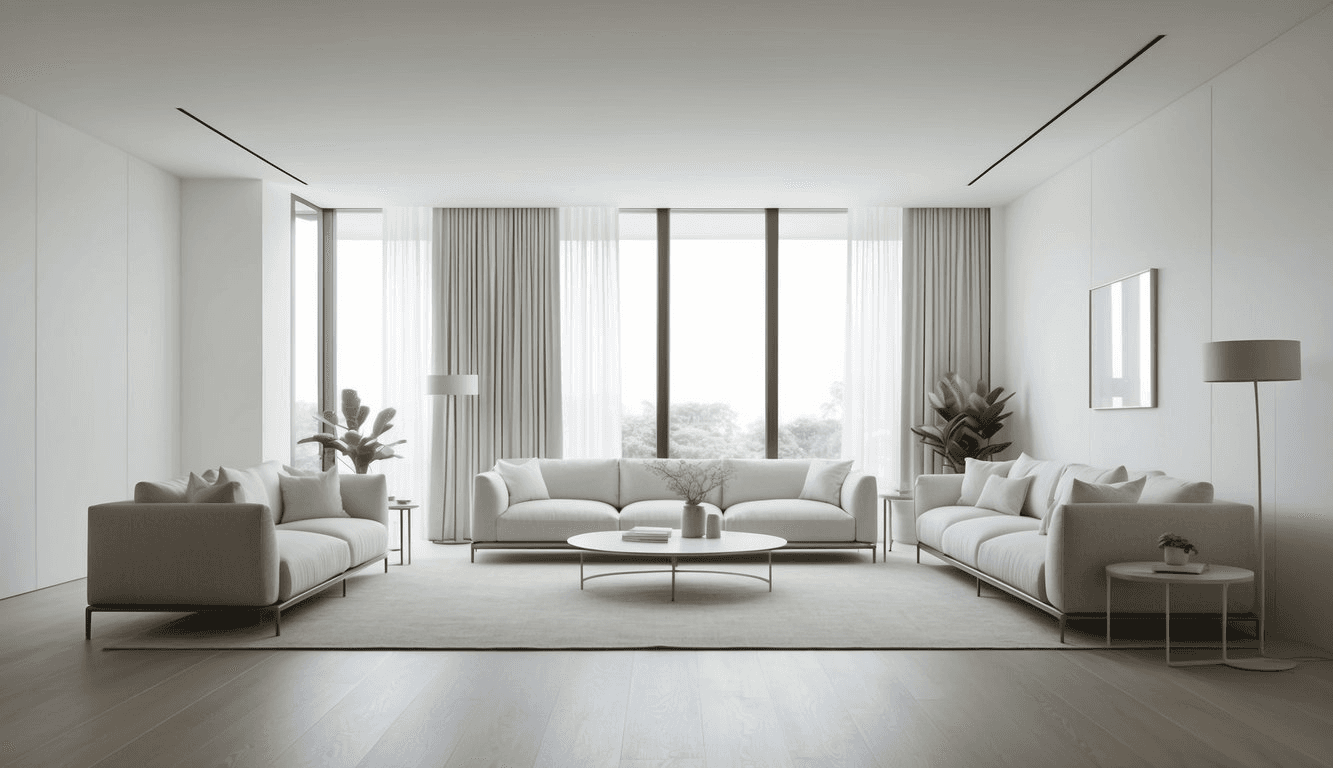
Minimalist design traces its roots to the early 20th century. It emerged as a reaction against the ornate and decorative styles of the 19th century.
The minimalist art movement of the 1960s heavily influenced interior design. Artists like Donald Judd and Dan Flavin championed simplicity and clean lines in their work.
Architects played a crucial role in shaping minimalist design principles. Ludwig Mies van der Rohe's famous phrase "less is more" became a guiding philosophy.
In architecture, minimalism favored open spaces and simple geometric forms. You'll notice a focus on functionality and the removal of unnecessary elements.
The Bauhaus school in Germany also contributed to minimalist ideals. Their approach emphasized clean lines, basic shapes, and a marriage of form and function.
Japanese design aesthetics greatly influenced Western minimalism. The concept of "Ma" - the beauty of empty space - resonated with minimalist principles.
In the 1980s and 1990s, minimalism gained popularity in interior design. You'd see spaces with neutral color palettes, uncluttered surfaces, and carefully chosen furnishings.
Architectural details in minimalist design often highlight natural materials. You might find exposed concrete, wood, or glass used to create visual interest without ornamentation.
Today, minimalist design continues to evolve. It adapts to modern lifestyles while maintaining its core principles of simplicity and functionality.
Minimalist Influence On Interior Design
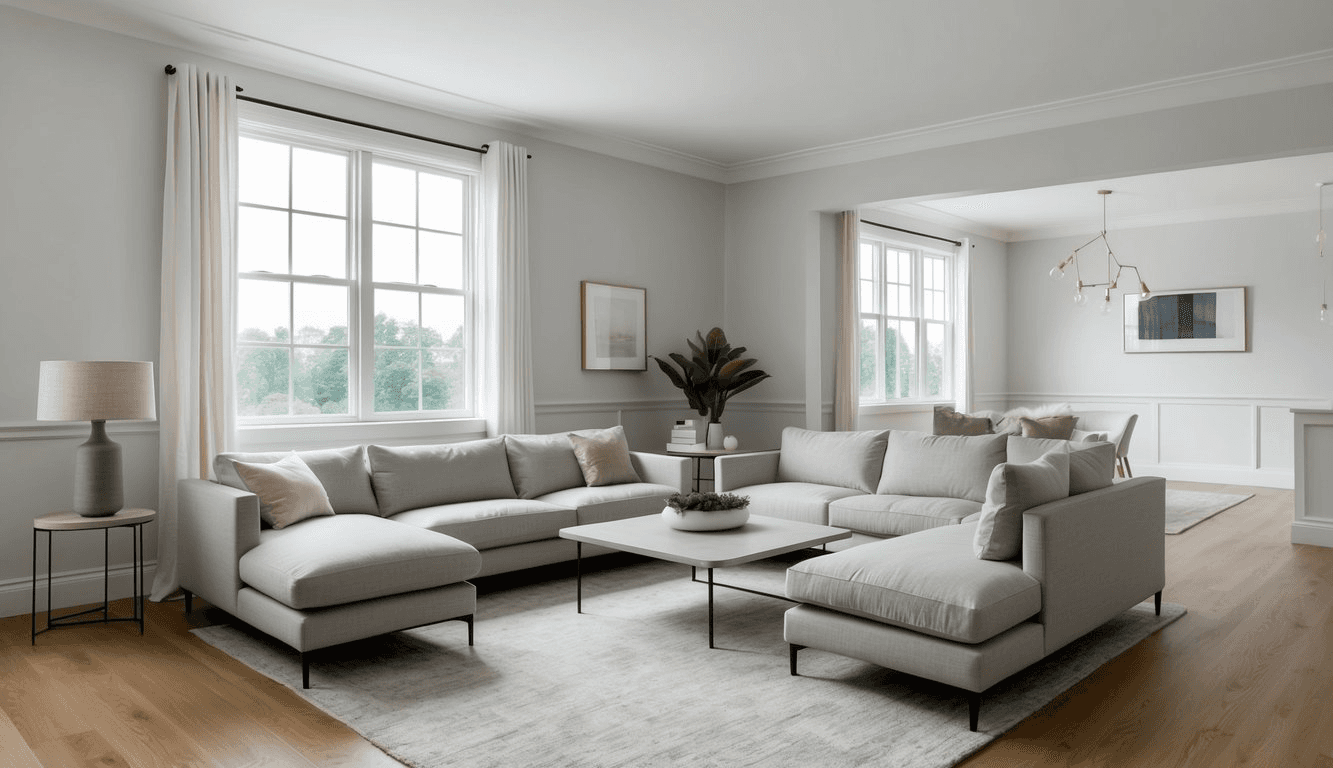
Minimalism has profoundly shaped modern interior design, emphasizing simplicity and functionality. You'll find that minimalist interiors focus on clean lines, open spaces, and a "less is more" philosophy.
In minimalist homes, every element serves a purpose. Clutter is eliminated, leaving only essential items that contribute to the space's function and aesthetic. This approach creates a sense of calm and order in your living environment.
Minimalist home design often incorporates a neutral color palette. Whites, grays, and earth tones dominate, creating a serene backdrop for daily life. Bold accents are used sparingly for maximum impact.
Furniture in minimalist interiors is typically sleek and multifunctional. You'll see pieces with clean lines and simple shapes, often in natural materials like wood or leather. Each item is carefully chosen to complement the overall design.
Lighting plays a crucial role in minimalist spaces. Large windows allow natural light to flood in, while carefully placed artificial lighting enhances the room's ambiance. This creates a bright, airy feel in your home.
Texture becomes more important in minimalist design. You might incorporate different materials like glass, metal, or textiles to add depth and interest without compromising the clean aesthetic.
The timeless aesthetic of minimalism ensures your space remains stylish for years to come. By focusing on quality over quantity, you create a home that's both beautiful and enduring.
Key Elements Of Minimalist Interior Design
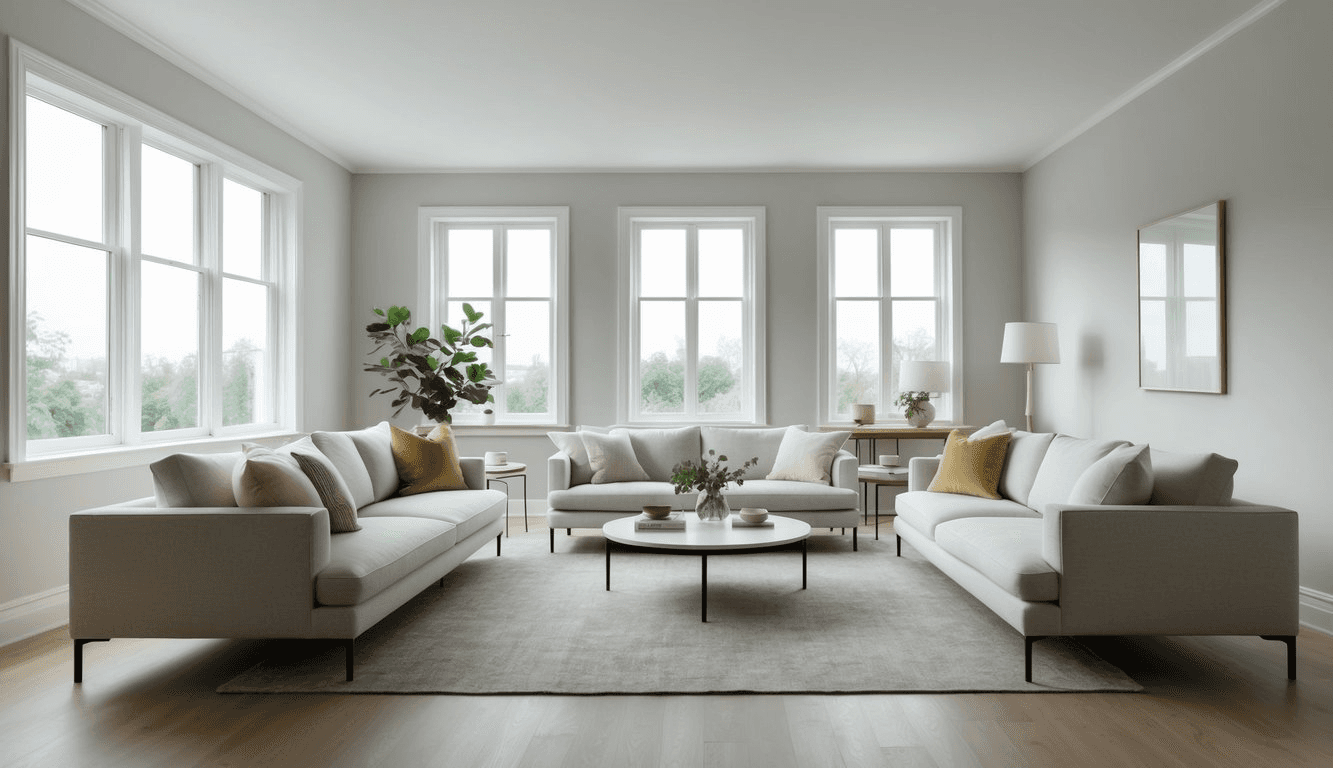
Minimalist interior design emphasizes simplicity, functionality, and clean aesthetics. It focuses on creating uncluttered spaces that promote a sense of calm and order.
Simple Color Palette
A minimalist color scheme typically revolves around neutral tones. White, beige, and gray form the foundation, creating a serene backdrop. You can incorporate subtle variations of these hues to add depth without overwhelming the space.
Consider using a monochromatic palette, exploring different shades of a single color. This approach maintains simplicity while adding visual interest. Black accents can provide contrast and definition to your minimalist interior.
For a touch of warmth, integrate earthy tones like soft browns or muted greens. These natural colors complement the neutral base while preserving the minimalist aesthetic.
Clean Lines And Geometric Forms
Minimalist design favors sleek, straight lines and basic geometric shapes. You'll find furniture and decor with crisp edges and simple silhouettes. Avoid ornate details or complex patterns that can disrupt the clean aesthetic.
Incorporate symmetry in your layout to create a sense of balance and order. Arrange furniture and decor items in aligned, parallel, or perpendicular configurations.
Use geometric shapes as design elements. Square or rectangular coffee tables, circular mirrors, or triangular shelving units can add visual interest while maintaining simplicity.
Functional Furniture
In minimalist interiors, every piece of furniture serves a purpose. Choose items that are both practical and visually appealing. Multi-functional furniture is particularly valuable in minimalist spaces.
Opt for sofas with clean lines and neutral upholstery. Consider a sleek dining table that can double as a work surface. Look for storage beds or ottomans with hidden compartments to maximize functionality.
Pay attention to the scale of your furniture. Oversized pieces can overwhelm a minimalist space, while too-small items may look out of place. Aim for a balanced proportion that complements your room's dimensions.
Intentional Negative Space
Negative space, or empty areas, plays a crucial role in minimalist design. It creates a sense of openness and allows the eye to rest. Resist the urge to fill every corner with furniture or decor.
Leave ample space between furniture pieces. This approach not only enhances the visual appeal but also improves flow and functionality. Consider an open floor plan to maximize the feeling of spaciousness.
Use negative space to highlight specific elements. A single piece of art on an otherwise bare wall can create a striking focal point. Empty shelves interspersed with carefully chosen objects can be visually appealing.
Natural Materials And Light
Incorporate natural materials to add warmth and texture to your minimalist interior. Wood, stone, and linen introduce organic elements without compromising simplicity.
Choose furniture with exposed wood grain or stone surfaces. Opt for natural fiber rugs or textiles to soften the space. These materials create a connection to nature and prevent the interior from feeling sterile.
Maximize natural light to enhance the minimalist aesthetic. Large windows or skylights can flood your space with sunlight, creating an airy atmosphere. Use sheer curtains or blinds to control light while maintaining a clean look.
Minimal Accessories
In minimalist design, less is more when it comes to accessories. Choose a few high-quality, meaningful pieces rather than cluttering surfaces with numerous items.
Display a single statement piece, such as a sculptural vase or a striking piece of art. Group similar objects in odd numbers for visual interest. Use open shelving to showcase a curated collection of books or ceramics.
Avoid overcrowding surfaces. A single plant, a carefully chosen lamp, or a minimalist clock can be sufficient to add character to a space without overwhelming it.
Simplified Lighting Design
Lighting in minimalist interiors should be functional and unobtrusive. Opt for fixtures with clean lines and simple shapes that complement your overall design aesthetic.
Consider recessed lighting or track systems to provide even illumination without visual clutter. Pendant lights with sleek designs can serve as both functional lighting and subtle decor elements.
Incorporate soft, ambient lighting to create a warm atmosphere. Use dimmers to adjust light levels and enhance the sense of calm in your minimalist space. Strategically placed floor or table lamps can provide targeted illumination while maintaining a clean look.
Substyles Of Minimalist Interior Design
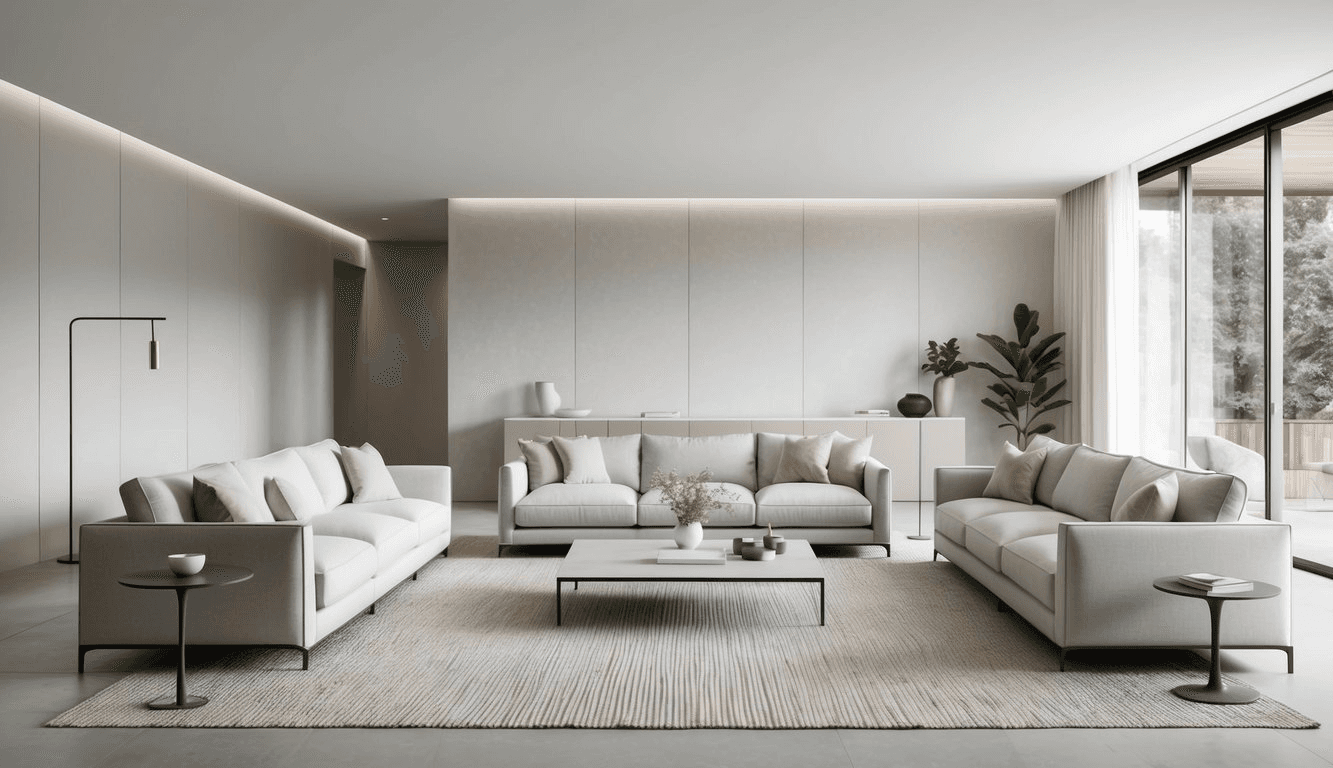
Minimalist interior design encompasses several distinct substyles, each with its own unique characteristics and aesthetic approach. These variations allow you to tailor minimalism to your personal preferences and lifestyle needs.
Scandinavian Minimalism
Scandinavian minimalism blends functionality with cozy elements. You'll find light color palettes dominated by whites, grays, and pale woods. Natural materials like wool, linen, and leather add texture and warmth.
Furniture pieces feature clean lines and organic shapes. Embrace open floor plans and maximize natural light with large windows and minimal window treatments.
Incorporate hygge elements like plush throws, candles, and plants to create a comfortable atmosphere. Opt for multifunctional furniture to maximize space efficiency.
Japanese Minimalism
Japanese minimalism, or Zen minimalism, focuses on creating tranquil, clutter-free spaces. You'll notice a strong emphasis on natural elements and a connection to the outdoors.
Choose low-profile furniture and floor seating options. Utilize sliding doors or shoji screens to divide spaces flexibly. Incorporate natural materials like bamboo, rice paper, and stone.
Stick to a neutral color palette with occasional pops of muted colors. Display a single piece of art or a carefully curated collection of objects as a focal point.
Warm Minimalism
Warm minimalism softens the stark feel often associated with minimalist design. You'll achieve this by incorporating earthy tones, textures, and organic shapes.
Choose furniture with curved lines and soft edges. Add warmth through materials like wood, leather, and woven textiles. Opt for a color palette of warm neutrals, including beige, tan, and soft browns.
Layer textures with rugs, throws, and cushions to create depth and visual interest. Use ambient lighting to create a cozy atmosphere.
Monochromatic Minimalism
Monochromatic minimalism relies on a single color or variations of one hue to create a cohesive look. You'll find this style particularly striking and visually impactful.
Choose a base color and incorporate various shades and tints throughout the space. Use texture to add depth and prevent the design from feeling flat.
Incorporate metallic accents or natural materials to break up the monochrome palette. Focus on form and silhouette to create visual interest within the limited color scheme.
Functional Minimalism
Functional minimalism prioritizes practicality and efficiency in design. You'll find every element serves a purpose, with little room for purely decorative items.
Opt for furniture with built-in storage solutions. Choose modular pieces that can be rearranged as needed. Implement smart home technology to reduce visual clutter.
Use vertical space effectively with wall-mounted shelving and storage units. Select multifunctional items like ottoman storage or extendable dining tables.
Keep surfaces clear and organize belongings in concealed storage. Prioritize quality over quantity when selecting furniture and decor items.
Room By Room Minimalist Design Ideas
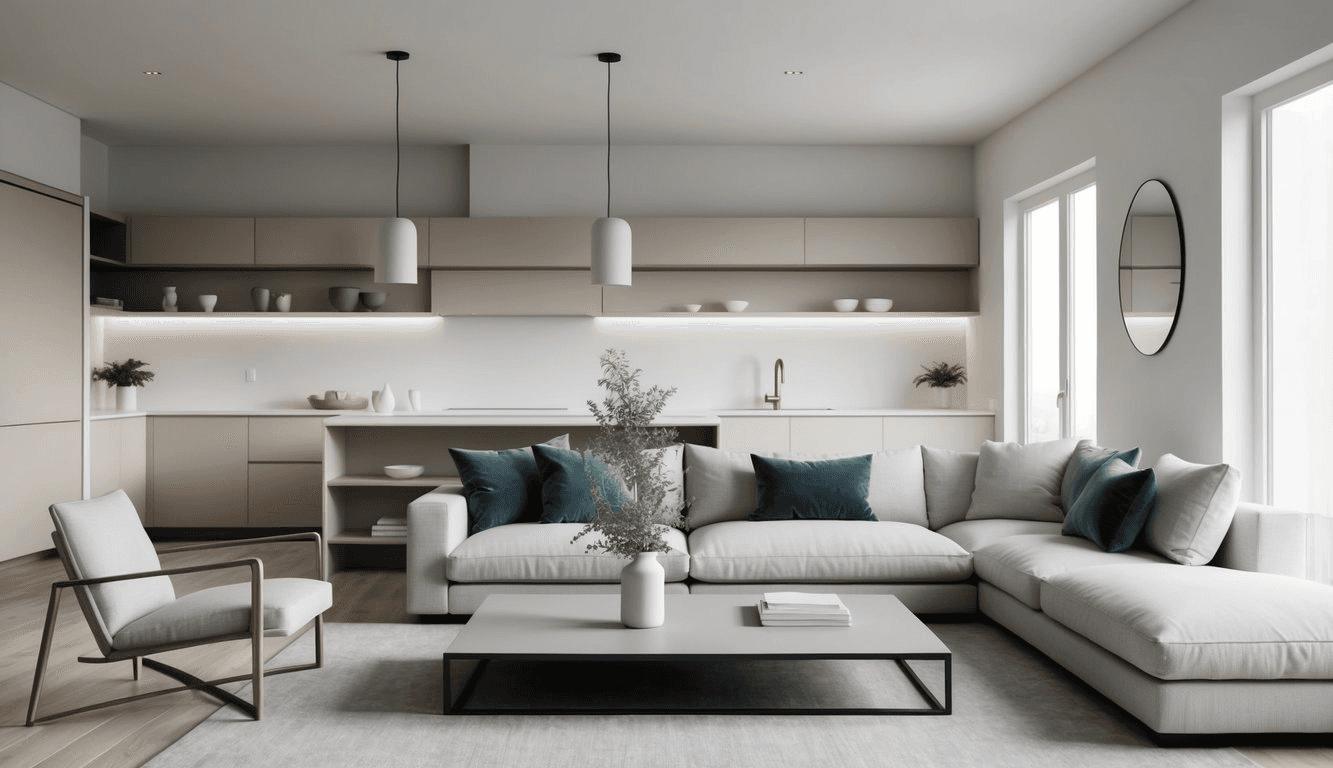
Embrace simplicity and functionality in each area of your home with these tailored minimalist design approaches. Focus on decluttering, selecting essential furniture, and incorporating smart storage solutions to create serene, purposeful spaces.
Living Room
Start by decluttering your living room. Keep only essential items and furniture that serve a purpose.
Choose a neutral color palette for walls and larger pieces. Opt for a sleek sofa with clean lines and add a few accent chairs if needed.
Incorporate hidden storage solutions like ottomans with interior compartments or floating shelves.
Select a minimalist coffee table with a simple design. Avoid unnecessary decorative items and instead focus on one or two statement pieces, such as a large piece of artwork or a sculptural lamp.
Use natural light to your advantage by keeping window treatments simple and unobtrusive.
Consider installing recessed lighting for a clean look. Keep technology hidden when possible, using cable management solutions and closed storage for electronics.
Kitchen
In the kitchen, prioritize clear countertops and open spaces. Choose streamlined cabinets with handle-free designs for a sleek look.
Opt for built-in appliances to maintain a cohesive appearance. Implement smart storage solutions like pull-out pantry shelves and drawer organizers to maximize space efficiency.
Select a neutral color scheme for cabinets and countertops, using materials like stainless steel or matte finishes for a modern touch.
Consider open shelving for frequently used items, keeping them neatly arranged.
Use under-cabinet lighting to enhance functionality without adding visual clutter. Choose a minimalist faucet and sink design to complement the overall aesthetic.
Bedroom
Create a tranquil bedroom environment by focusing on essentials. Choose a simple bed frame and invest in high-quality bedding in neutral tones.
Opt for a minimalist nightstand with built-in charging ports to reduce cord clutter. Utilize under-bed storage for seasonal items or extra linens.
Install a sleek, built-in wardrobe system to keep clothing organized and out of sight. Consider a floor-length mirror to create the illusion of more space.
Keep décor minimal, with perhaps one piece of artwork as a focal point.
Use soft, dimmable lighting options to create a calming atmosphere. Choose window treatments that provide privacy while maintaining a clean look, such as simple roller blinds.
Bathroom
Apply minimalist principles to your bathroom by selecting fixtures with clean lines and simple designs. Choose a floating vanity to create a sense of space and make cleaning easier.
Opt for a frameless glass shower enclosure for a seamless look. Implement clever storage solutions like recessed medicine cabinets and wall-mounted organizers.
Keep countertops clear by storing toiletries in drawers or cabinets. Choose matching containers for necessary items left in view.
Use large-format tiles or seamless surfaces to reduce visual clutter. Select a neutral color palette and incorporate natural materials like stone or wood for warmth.
Install good lighting, including task lighting around the mirror, to enhance functionality.
Home Office
Design a productive minimalist home office by selecting a desk with a clean, simple design and built-in cable management. Choose an ergonomic chair that complements the aesthetic without sacrificing comfort.
Implement a filing system to keep papers organized and out of sight. Use wall-mounted shelves or a sleek bookcase for necessary storage.
Keep your desktop clear, with only essential items like a computer and task lamp. Incorporate a bulletin board or whiteboard for ideas and planning, but keep it organized.
Choose a neutral color scheme to promote focus and calm. Use natural light when possible, supplemented by task lighting to reduce eye strain.
Why Choose Minimalist Design
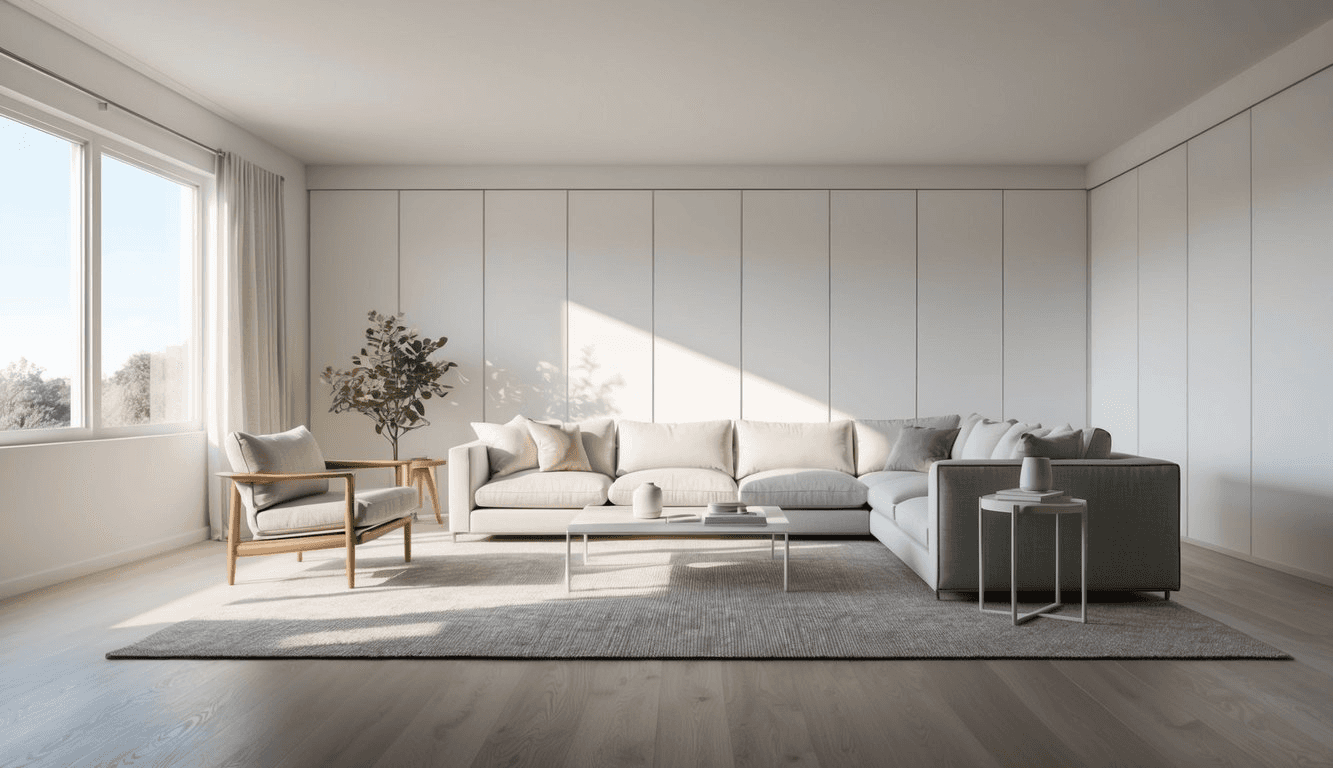
Minimalist design offers a path to tranquility in your living space. By embracing this style, you create a serene environment that promotes mental clarity and relaxation.
A minimalist lifestyle encourages mindful consumption. You'll focus on quality over quantity, carefully selecting items that truly add value to your home and life.
Sustainability is a key benefit of minimalism. By owning fewer possessions, you reduce waste and your environmental impact. This approach aligns with eco-conscious values.
The calming atmosphere of a minimalist home can significantly reduce stress. Clean lines and uncluttered spaces allow your mind to rest and recharge.
Minimalism simplifies cleaning and maintenance. With fewer items to manage, you'll spend less time tidying and more time enjoying your space.
A serene ambiance enhances creativity and productivity. Your minimalist surroundings can inspire focus and clear thinking, benefiting both work and personal projects.
Financial benefits arise from minimalist choices. You'll spend less on unnecessary items and may find yourself valuing experiences over material possessions.
Minimalist design is timeless. By choosing classic pieces and neutral colors, you create a look that remains stylish for years to come.
Get Started With Onton
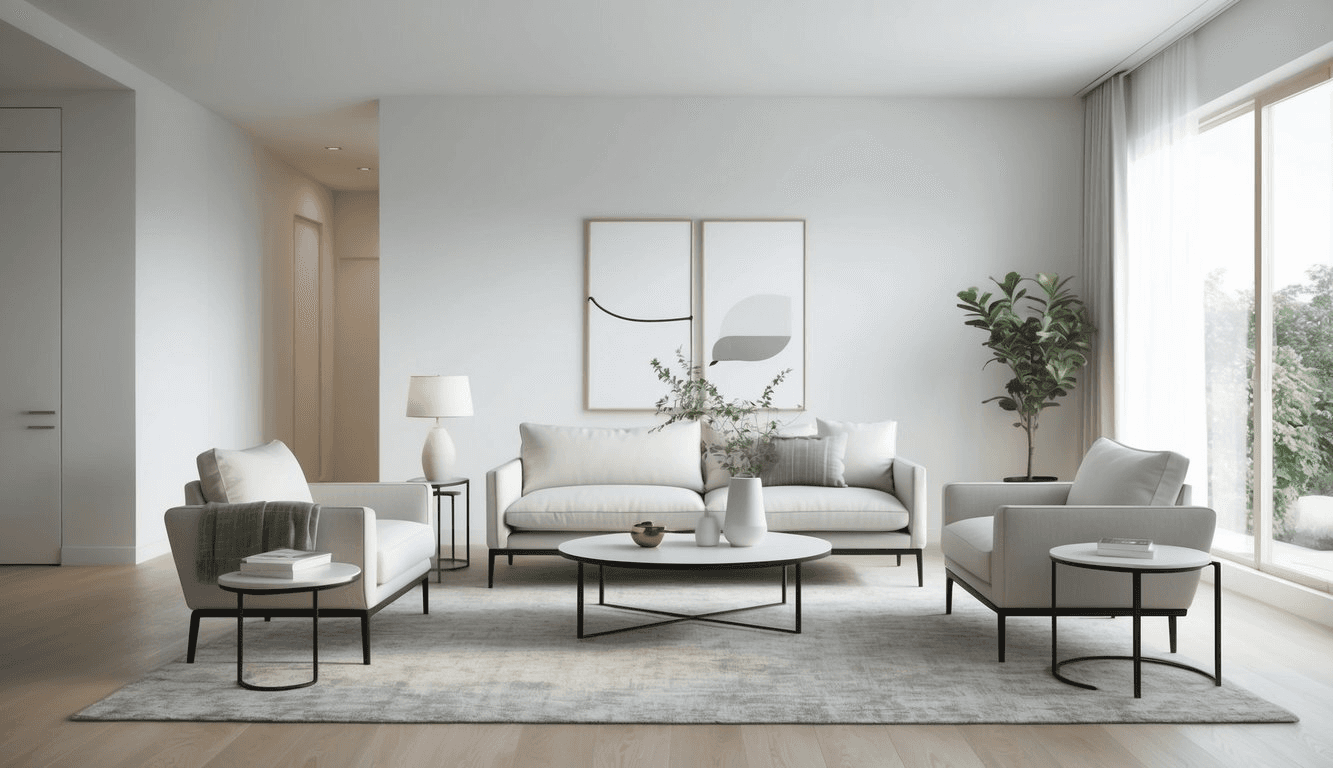
Onton offers an innovative AI tool to help you explore minimalist interior design. To begin, simply upload a photo of your room. Make sure the image is well-lit and properly oriented for optimal results.
Once you upload your photo, you can start experimenting with different minimalist styles. Use prompts to guide the AI in creating your desired look. For example, try "Bauhaus living room with red, yellow, and blue accents and sleek furniture."
If you don't have a photo, don't worry. Onton can design entirely new spaces from scratch based on your descriptions.
Explore various color palettes and furniture styles to find the perfect minimalist aesthetic for your space. Focus on neutral tones and clean lines to achieve that classic minimalist look.
Remember, minimalism is about simplicity and functionality. As you use Onton, aim to create uncluttered spaces that highlight the essentials of your room.
Take advantage of Onton's free features to start your minimalist design journey. Premium options are available for even more customization.
With Onton, you can transform your living space into a sleek, minimalist haven in just 30 seconds. Start experimenting today and discover the power of AI-assisted interior design.

